Adalaj is a small town near Gandhinagar, the capital city of Ahmedabad, famous for the 15th century stepwell. Adalaj Stepwell once was one of larger resting places in region, on a trade route of medieval period. With a splendid architecture Adalaj Stepwell still a primary attraction for tourists and history lovers.
The history of Adalaj Stepwell is deeply connected with the story of Rani Rudabai, the famous queen of former ‘Dandai Desh’. Hence, Adalaj Stepwell is also famous Rani Rudabai Stepwell or Rani Rudabai ni Vav.
Stepwells were purposefully built to preserve rain water for hot summers. During ancient and medieval period, as the trade routes formed, local rulers had built many stepwell to encourage the traders. Several hundreds of stepwells are therefore visible in the arid areas of Rajasthan, Gujarat and other parts of northern India, along the trade routes. There are more than 140 stepwells are existing in the state of Gujarat. Adalaj Stepwell is definitely one of the top rated stepwells in Gujarat.
Adalaj Stepwell is locally known as ‘Adalaj ni Vav’. The word ‘Vav’ is a Gujarati word which means stepwell. Hence, local Gujrati speakers call it Adalaj ni Vav. Similarly local Hindi speakers call it ‘Adalaj ki vav’ or simply ‘Adalaj Vav’.
History of Adalaj Stepwell: Queen Rudabai story
Adalaj Stepwell history has a deep link with Rani Rudabai, the queen of Dandai Desh. The land of Dandahi Desh was under rule of Rana Veer Singh of Vaghela dynasty. Rana started the construction work of Adalaj Stepwell in late 15th century, arguably in 1499 CE. But before Veer Singh could complete the project, Mahmud Begada attacked the kingdom. Unfortunately, Rana lost his life in the battle.
Rana’s widowed queen Rudabai, wanted to commit Jauhar (self-immolation on husband’s pyre). But Begada, awestruck by her beauty persuaded her to relent and proposed a marriage. Rani Rudabai was clever enough to sense the opportunity to buy some time to finish the incomplete project of the stepwell. She agreed to Mohammed Begada’s proposal but only against his acceptance to finish the incomplete project before the marriage. Begda agreed and constructed the stepwell in quick time. The construction work finally finished in early 16th century.
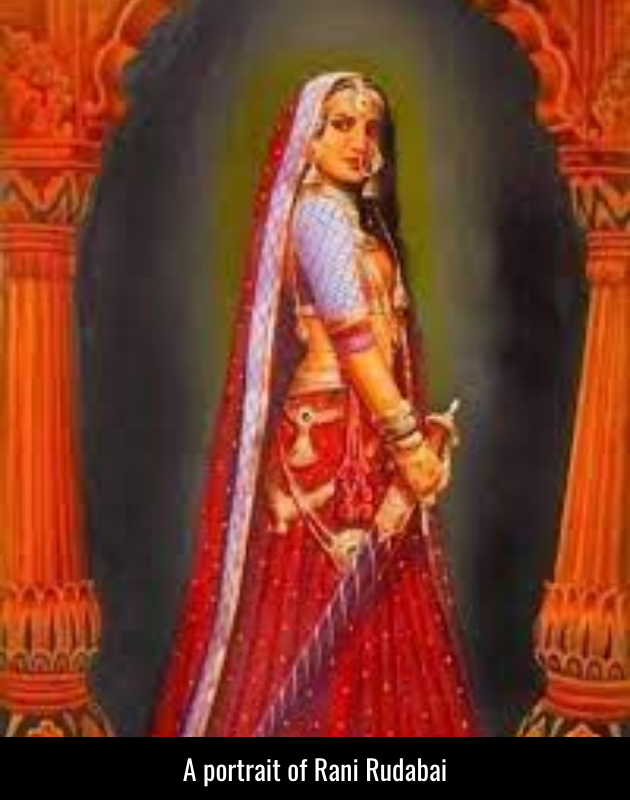
But, Rani Rudabai never really had any will to marry Begada. After the stepwell work finished, she opted to commit a suicide and jumped into the stepwell. She also knew the stepwell will become a cursed one after she committs suicide. Hence, she asked few Hindu saints to perform necessary rituals after her death.
Clever act from Rani Rudabai only made the construction of Adalaj Stepwell possible. Therefore, people still remember the sacrifice of Rani Rudabai together with Adalaj ni Vav.
Sanskrit Inscription of Adalaj Stepwell
An old Sanskrit inscription appears at the first floor of Adalaj Ni Vav, which fairly states history and constrution of the stepwell. The insription was engraved on a marble slab.
The inscription states:
“Samvat 1555 (1498 AD), month of Magha, Mahmud Padshah being king.
“Salutation to Vinayaka (Ganesha) to whose race belonged King Mokala, chief of the country of Dandahi. From him was born Karna, Mahipa and Virsinh and Naisha were the sons of Mahipa. Virsinh’s queen, whose name is Rooda, has constructed this well.
“It is dedicated at this time – when the sun is in the north, the month is Magha, the bright half (Shukla Paksha), the 5th day, the day of the week, Wednesday, the lunar mansion – Uttara, Karana-Bava, the yoga – Siddhi.”
– sourced from Wikipedia
Adalaj Stepwell Architecture
The monument of Adalaj exhibits one of the finest stepwell architectures in western India. Intricate carvings on the pillars of Adalaj Stepwell illustrate classic Solanki Architecture. The architecture was originated as a famous 11th century temple architectural style of western India. But with the rise of Islamic architecture i 14th century, use of this architecture started declining. Surprisingly, a healthy mix of Solanki Architecture with 15th century Indo-Islamic Architecture is noticeable at Adalaj ni Vav.
Solanki Architectural brilliance
The columns and beams carry delicate engraving work which is the primary identity of Solanki Architecture. Some of the artworks at the columns are purely decorative, havings no contribution in structural mechanics. Symbols of Hindu and Jain gods were intricately carved at various levels of the well.
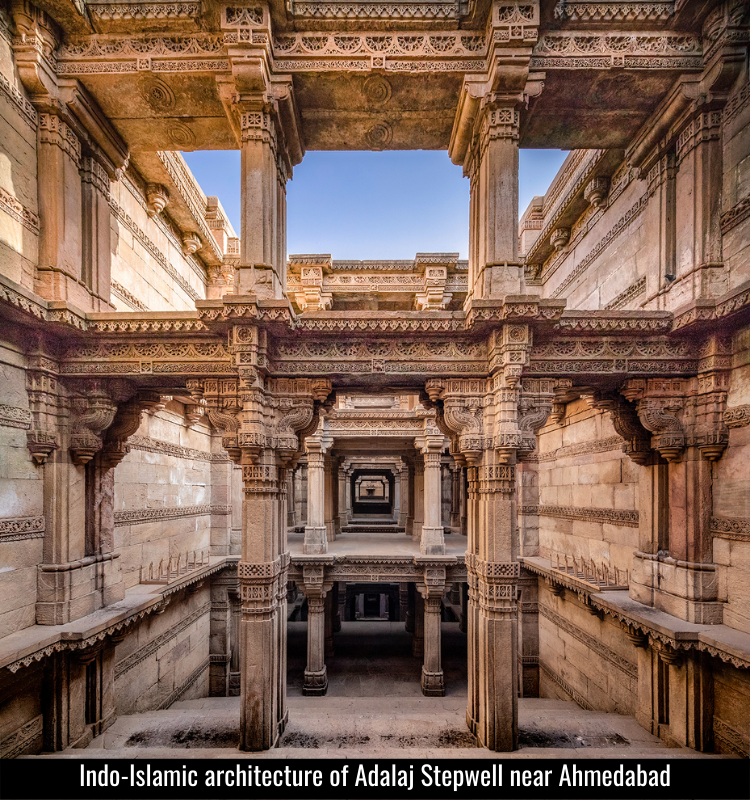
The structure of Adalaj Stepwell has five floors, entirely built with red sandstones. From the first story level, three staircases lead to the lowest floor to access water, which indeed is a unique feature.
Another great feature of Adalaj Stepwell architecture is that the entire construction stands on a north–south axis. Entrance is however exists at the south. It has three staircases those lead to the landing level from the south, west and east directions respectively. The landing level, is however on the northern side of the well.

The principal well of Adalaj ni Vav has an octagonal shape which is open at the top. Suprisingly, the landing level also lacks any ceiling which makes a fairly large space for light and air circulation. However, the amazing architecture of Adalaj ni Vav restricts direct Sun light to reach the water level, except at the noon. It is probably the best feature of Adalaj Stepwell architecture, creating a cooler atmosphere of 6 to 8 degrees of celcius from outside ambient temperature.
Islamic artistry
Several glimpses of Islamic Architecture is noticeable at Adalaj Stepwell alongside the old Indian Solanki Architecture. Exquisite floral patterns in Islamic style blend beautifully with Indian creativity to produce one of the finest Indo-Islamic Architectures of Gujarat region.

Four small rooms with oriel windows appear at at the four corners of the landing level. Each of the brackets have elegant Islamic carvings, undoubtedly carried out by Mahmud Begada. The walls have carvings of women performing daily chores such as churning of buttermilk, adorning themselves etc. Further, scenes of the performance of dancers and musicians, and the King overlooking all these activities are also visible.
Summing up
Trade route of present Gandhinagar region influenced Rana Veer Singh to encourage the traders with a place to rest and relax. His demise in the midway of construction brought a pause until Rani Rudabai stepped in to trap Mahmud Begada to finish up the pending work.
Two different phases of construction eventually helped two completely different cultures to merge and produce a mixed architecural marvel. The floral graphics of Islamic Architecture did blend very well with the Solanki graphics of Hindu gods and goddesses. Adalaj Stepwell architecture is therefore considered as one of the finest representation of Indo-Islamic Architectures.
Tourist Information of Adalaj Stepwell: Entry fees and timings
Rani Rudabai Stepwell alias Adalaj ni Vav has no entry fees. The site of Adalaj Stepwell is open for tourists and history explorers from 6:00 AM to 6:00 PM, on all seven days of the week.
Cameras and mobiles are all allowed inside the stepwell premise. No restrictions of photography or videography.
Adalaj Stepwell is very close to Gandhinagar, the capital city of Gujarat, within the vicinity of 5 kilometers. Ahmedabad city is also not that far, just 11 kilometers via road.
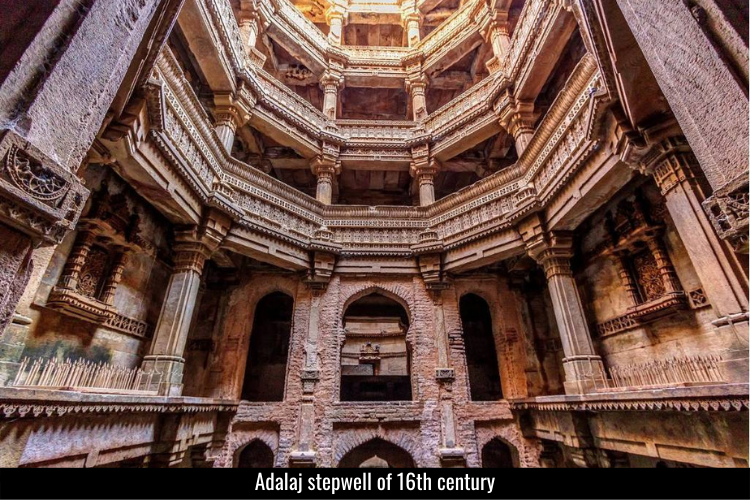
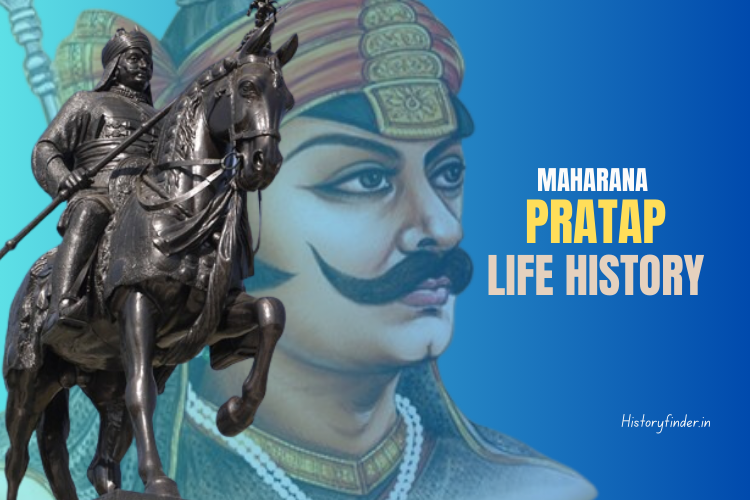
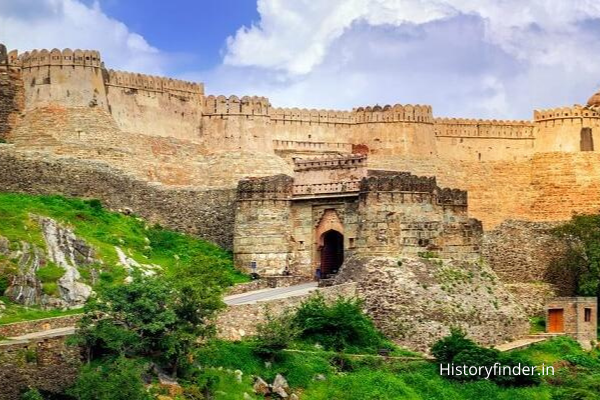
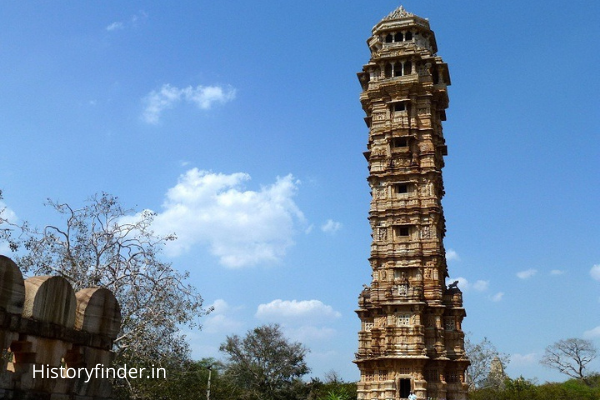
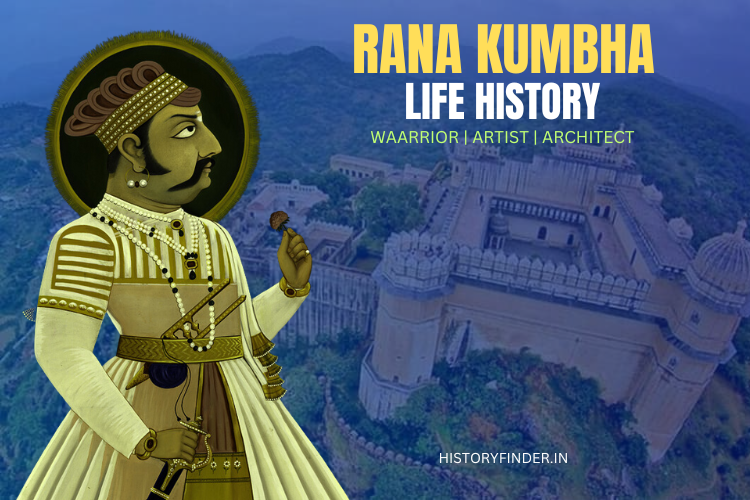
Pingback: Dada Harir Vav: A 15th century Solanki architecture in Gujarat -
Pingback: Dada Harir stepwell history -